
A little crab
is enough to change the world

is enough to change the world
Chitin, which is widely found in shrimp and crab shells, is a polysaccharide made by the polymerization of N acetyl glucosamine.
Chitin is deacetylated to obtain chitosan.
In the past ten years, the research on chitin and chitosan has been widely carried out at home and abroad, and their functions in anti-tumor and prevention and treatment of pathogenic microorganisms have attracted more and more attention. However, due to its insoluble water, it is very limited in the development of applications. To this end, chitosan is degraded into Chito-oligosaccharides (also known as oligosaccharides, chitosan oligosaccharides, chitosan oligosaccharides) by appropriate methods, that is, oligosaccharides composed of 2~10 aminoglycoses linked by β-1-4 glycosidic bonds.
Through a series of experiments, it has been found that it not only has good water solubility, is easy to be absorbed by the human body, but also has a variety of physiological functions such as antibacterial, anti-tumor, blood lipid regulation, immune regulation and activation of intestinal bifidobacteria, and the application field has been greatly broadened.
Chito-oligosaccharides has a unique application value in fine chemicals, biomedicine, health food, agriculture, forestry and animal husbandry.

Chito-oligosaccharides chemical structure
Chito-oligosaccharides is a multifunctional biopolymer derived from chitin that has been widely used in several industries due to its unique properties. This biodegradable and non-toxic compound offers a range of advantages in various areas:
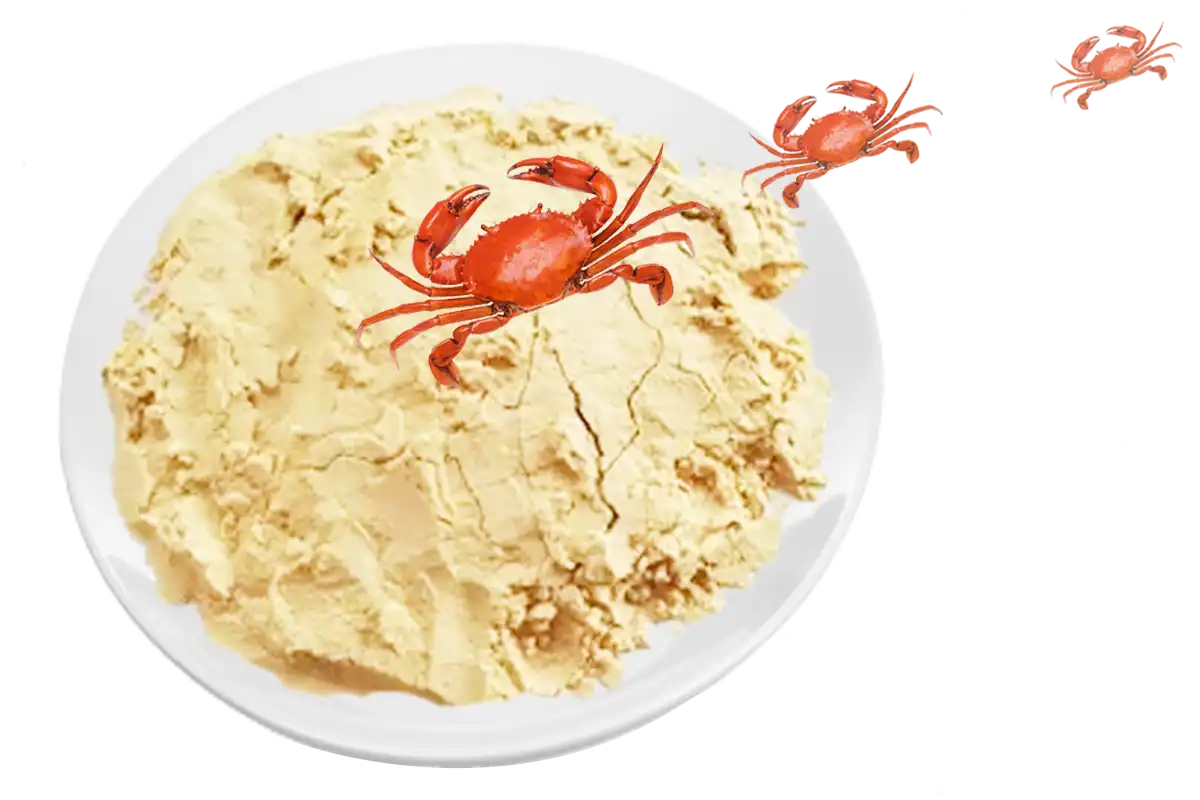
Chito-oligosaccharides have been shown to have a variety of benefits in winemaking. It improves the clarity and stability of the wine, as well as reduces the level of unwanted compounds and off-flavors. Chitosan can also act as a natural preservative, which can extend the shelf life of wine and reduce the need for synthetic additives.
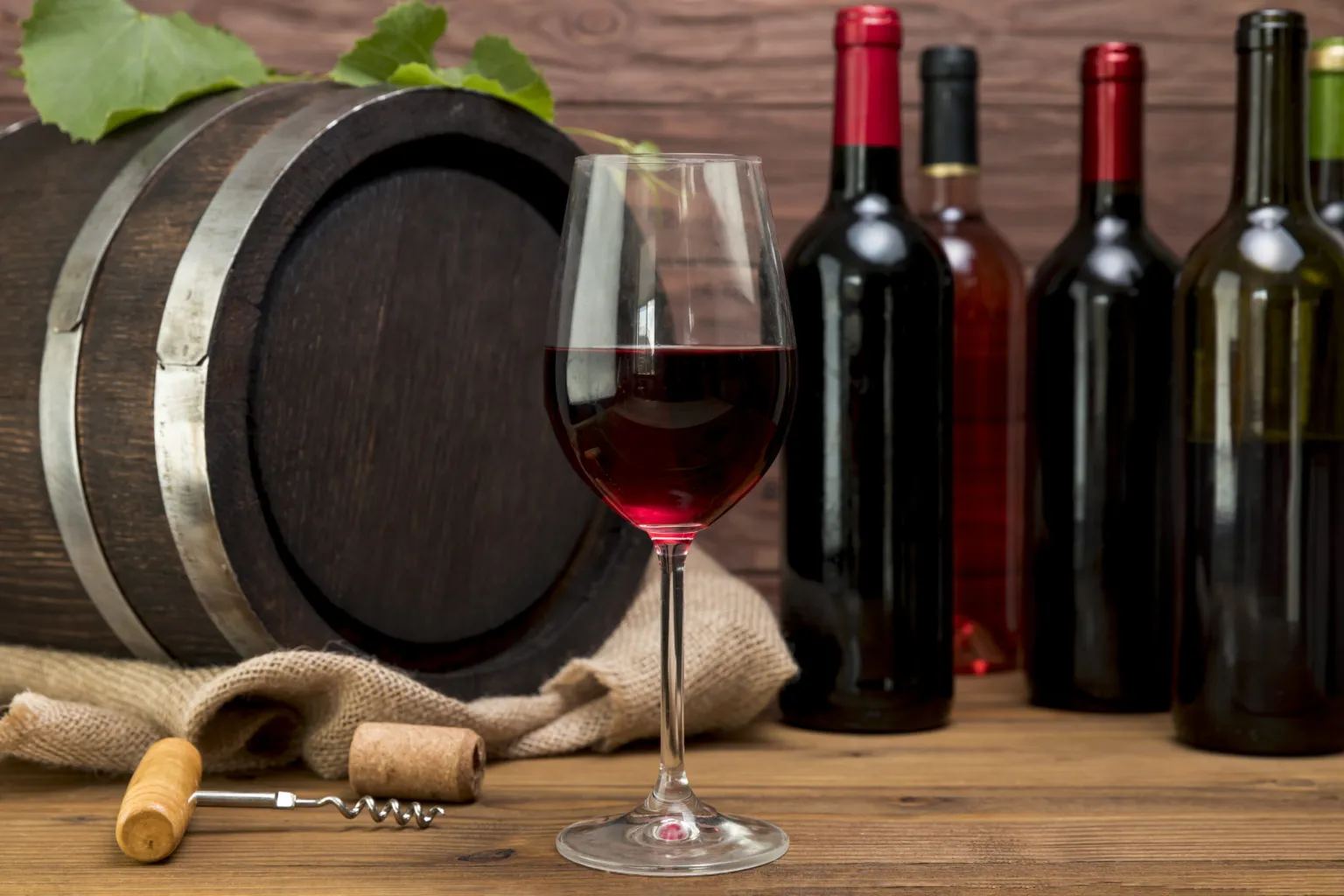
One of the main advantages of Chito-oligosaccharides is its ability to bind to proteins, tannins, and phenolic compounds in wine and remove unwanted compounds.
This helps to reduce the risk of cloudiness formation and improves the clarity and brightness of the wine. Additionally, Chito-oligosaccharides can help reduce the amount of sulfites, which are commonly used as preservatives in wine and can cause allergic reactions in some people.
Chito-oligosaccharides can also improve the stability of the wine by reducing the risk of sedimentation and sedimentation. This helps prevent the loss of flavor and aroma compounds and ensures the quality of the wine over time. In addition, Chito-oligosaccharides can act as a natural antioxidant, helping to prevent oxidative damage and preserve the freshness and flavor of wine.
It is used as a fining agent for the treatment of flotation clarified grape juice to reduce the content of turbid and labile colloids.
It is also used to stabilize wine. This polymer actually helps eliminate unwanted microorganisms, such as brettanomyces

The use of Chito-oligosaccharides in winemaking promotes sustainability and reduces the environmental impact of wine production.
Chitosan is biodegradable and does not accumulate in the environment, making it a safe and sustainable winemaking solution.
The application of Chito-oligosaccharides in wine has been extensively studied, and the results have shown its effectiveness and safety.
Chito-oligosaccharides have been approved as safe and effective additives in winemaking by regulatory agencies such as the European Union and the U.S. Food and Drug Administration. In addition, Chito-oligosaccharides has been shown to have no adverse effect on the organoleptic properties of wines, as it does not affect the taste, aroma or color of the wines.

Chito-oligosaccharides is an effective and sustainable solution for wine applications. Its unique properties, such as debris removal, enhanced stability, and natural preservation, make it an attractive alternative to animal-derived additives.
In addition, the use of Chito-oligosaccharides promotes sustainability and reduces the environmental impact of wine production. Therefore, it is expected that the use of Chito-oligosaccharides in the wine industry as a safe and sustainable additive will continue to grow.
The dosage of Chito-oligosaccharides in wine, beverages, and alcohol varies depending on the specific product and expected usages.
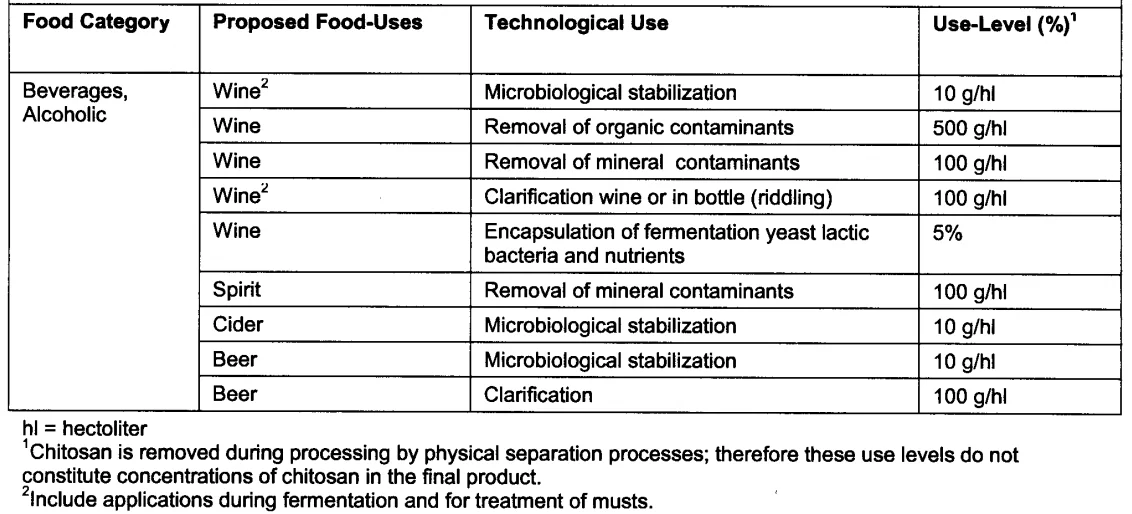
Chito-oligosaccharides Dosage in Wine, Beverages, Alcohol (for reference only)
In wine, Chito-oligosaccharides are often used as fining agents to clarify wine by removing unwanted particles such as sediment and turbidity. The dosage of Chito-oligosaccharides in wine can vary depending on the characteristics of the wine and the degree of clarity required. Typically, a dose of 5 to 100 grams per hectoliter (100 liters) of wine is used, but it is important to follow the manufacturer's instructions and conduct experiments before use to determine the optimal dose.
In beverages such as fruit juices, cider, and soft drinks, Chito-oligosaccharides are commonly used as stabilizers and thickeners. The dosage of Chito-oligosaccharides in these drinks can vary depending on the specific product and the desired texture and stability. In general, use a dose of 10 grams per hectoliter (100 liters), but it is also important to follow the manufacturer's instructions and conduct experiments before use to determine the optimal dose.
In alcoholic beverages such as beer and spirits, Chito-oligosaccharides can be used as a fining agent to remove unwanted particles and cloudiness. The dosage of Chito-oligosaccharides in these drinks may vary depending on the specific product and the level of clarification required. Typically, the dosage per hectoliter of beer is 10 to 100 grams, but it is important to follow the manufacturer's instructions and conduct trials before use to determine the optimal dose.

US FDA Aspergillus niger chitosan dosage: Authorized for use in wine processing
It is important to note that the dosage of Chito-oligosaccharides may vary depending on the specific product and desired results, it is always advisable to consult the manufacturer's instructions and conduct a trial before use to determine the best dosage for your specific application.
In the wine industry, B. bruxellensis is often considered a spoilage yeast, and it and other members of the genus are often referred to as brett. Its metabolites can give the wine aromas of "sweaty saddle leather", "barn", "burnt plastic" or "band-aid". Some winemakers in France, and occasionally elsewhere, consider it an ideal addition to wine. Some vintners believe that Brett is responsible for 90% of spoilage in fine red wines.
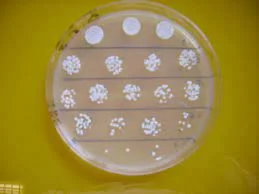
Brussels brettanomyces
This unwanted yeast is able to age under difficult conditions. The development of this microorganism often leads to the development of odors, such as ethylphenols and vinylphenols.
In fact, the organoleptic properties of these molecules (mostic, animal, horsy, barnyard, smory, spicy, picry, burned plastic, or medicinal) are often described as Brett characteristics.
It is also responsible for the production of other negative aromatic compounds, such as isovaleric acid (known to be associated with an unpleasant cheesy aroma) and tetrahydropyridine, which are responsible for mousse pollution.
Nowadays, on an international scale, the attention to this defect has become great, and Brettanomyces bruxellensis is considered to be the main microbial cause of wine spoilage worldwide, causing huge economic losses.
Brettanomyces bruxellensis is ideally suited for winemaking conditions as it is resistant to low pH and ethanol, facultatively anaerobic, and can absorb alternative hexose carbon sources.
Therefore, Brettanomyces bruxellensis and its consequences in wine pose a constant threat to wine quality, and how to eliminate and control Brettanomyces bruxellensis is an important key topic.
Over the past few years, from many operators in the wine industry, Chito-oligosaccharides have been validated as a new tool for the control of Brussels' brettanomyces in winemaking.
Chito-oligosaccharides are linear polysaccharides composed of two repeating units [D-glucosamine unit (GlcN) and N-acetyl-D-glucosamine (GLcNAc) unit] randomly distributed along the polymer chain and linked by β(1-4) bonds.
Recent studies have shown that the effect of Chito-oligosaccharides application on wine contaminated with Brettanomyces bruxellensis leads to the elimination of Brettanomyces bruxellensis cells.
In these studies, the Chito-oligosaccharides preparation was added, the wine was dried after 10 days, and treatment efficiency was assessed with a short delay after treatment.
The focus of this study is to evaluate the effects of different addition regimens of olefin glycan formulations on the evolution of Brussels brettanomyces population and volatile phenolic content with senescence for up to 9 months.
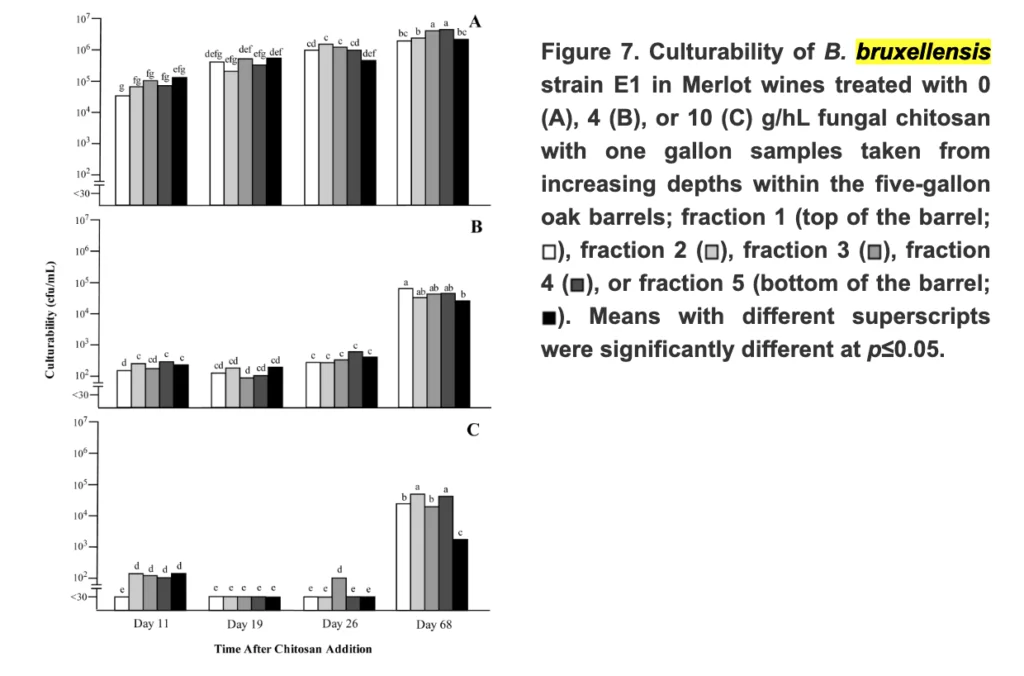
At the same time, other recent studies have shown that the effect of Chito-oligosaccharides application 9 on wines contaminated with Brettanomyces bruxellensis leads to the elimination of Brettanomyces bruxellensis cells, even in populations with high levels of up to 10 5 -10 6 CFU/mL.
Due to the fact that the stability of the wine microbiota must be controlled during aging in oak barrels, our research focuses on the application of the Chito-oligosaccharides preparation to prevent contamination of wine by Brussels brettinia during aging at the experimental winery and winery scale.
In addition, since previous studies have reported that efficient management of malolactic fermentation (MLF) can help maintain the quality of wines by stunting the development of Brettanomyces devisiae, the application of Chito-oligosaccharides treatment in this work has been carried out on wines that have received rapid MLF (by yeast-bacterial total inoculation) and wines that have received slow MLF (carried out by spontaneous microbial communities).
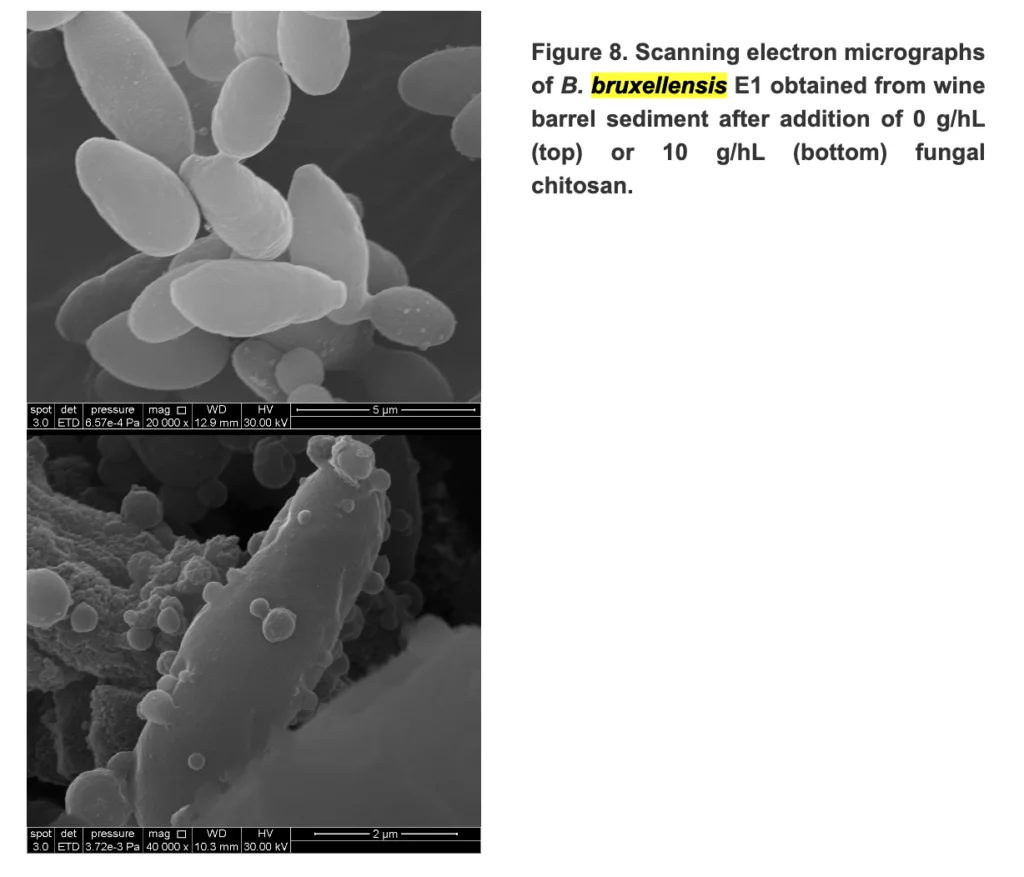
The results confirm the role of Chito-oligosaccharides in wine aging as a preventive tool for the control of Brettanomyces bruxellensis, the consequences of which develop in wine pose a constant threat to wine quality.
Chito-oligosaccharides is a biopolymer derived from chitin, a naturally occurring polymer found in shellfish. In wine applications, Chito-oligosaccharides can be used as a fining agent. Fining agents are substances that are added to wine to remove unwanted impurities such as sediment, cloudiness, or off-flavors, and to improve the clarity and stability of the wine.

All in all, Chito-oligosaccharides can be an effective and sustainable alternative to animal-based fining agents in the wine industry.
The service has a warm connection with the customer